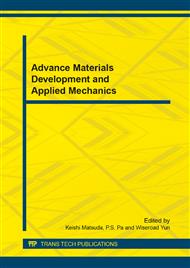[1]
Akbar Eshaghi, Alireza Grae , Optical and electrical properties of indium tin oxide (ITO) nanostructured thin films deposited on polycarbonate substrates "thickness effect. Original Research[J]. Article Optik - International Journal for Light and Electron Optics, 2014, 125: 1478-1481.
DOI: 10.1016/j.ijleo.2013.09.011
Google Scholar
[2]
PanCA, MaTP. Hight-quality transparent conductive indium oxide prepared by thermal evaporation[J]. Applied Physics Letter, 2009, 37: 163-165.
DOI: 10.1063/1.91809
Google Scholar
[3]
Hamid Reza Fallah, Mohsen Ghasemi, Mohammad Javad Vahid, et al. Substrate temperature effect on transparent heat reflecting nanocrystalline ITO films prepared by electron beam evaporation. Renewable Energy[J]. 2010, 35: 1527-1530.
DOI: 10.1016/j.renene.2009.10.034
Google Scholar
[4]
Davood Raoufi, Ahmad Kiasatpour, Hamid Reza Fallah, et al. Surface characterization and microstructure of ITO thin films at different annealing temperatures[J]. Original Research Article Applied Surface Science, 2007, 253: 9085-9090.
DOI: 10.1016/j.apsusc.2007.05.032
Google Scholar
[5]
TJ Choutts, DL Young, XN Li. Characterization of transparent conducing oxides[J]. MRS Bulletin, 2000, 25-8: 58-65.
Google Scholar
[6]
A Ershov, L Pekker A Ershov, L Pekker. Model of d. c. magnetron reactive sputtering in ArO2 gas mixtures[J]. Original Research Article Thin Solid Films, 1996, 289: 140-146.
DOI: 10.1016/s0040-6090(96)08930-4
Google Scholar
[7]
M. Sobri, A. Shuhaimi, V. Ganesh, et al. Effect of annealing on structural optical and electrical properties of nickel (Ni)/indium tin oxide (ITO) nanostructures prepared by RF magnetron sputtering[J]. Original Research Article Superlattices and Microstructures, 2014, 70: 82-90.
DOI: 10.1016/j.spmi.2014.02.010
Google Scholar
[8]
R. Rakesh Kumar, K. Narasimha Rao, K. Rajanna, et al. Low temperature and self catalytic growth of ultrafine ITO nanowires by electron beam evaporation method and their optical and electrical properties[J]. Original Research Article Materials Research Bulletin. 2014, 52: 67-176.
DOI: 10.1016/j.materresbull.2014.01.022
Google Scholar
[9]
Yue Zhao, Fuwen Qin, Yizhen Bai, Zhenhe Ju, et al. Low temperature synthesis of GaN films on ITO substrates by ECR-PEMOCVD[J]. Original Research Article Vacuum, 2013, 92: 77-80.
DOI: 10.1016/j.vacuum.2012.11.003
Google Scholar
[10]
Sewook Oh, Hunsang Jung, Yo-Han Kim, et al. Characterization of ITO etching by spontaneously evaporated fume of hydrogen chloride[J]. Microelectronic Engineering. 2013, 103: 173-176.
DOI: 10.1016/j.mee.2012.09.021
Google Scholar
[11]
Bi-Shiou Chiou, Shu-Ta Hsieh. R. f. magnetron-sputtered indium tin oxide film on a reactively ion-etched acrylic substrate[J]. Thin Solid Films, 1993, 229: 146-155.
DOI: 10.1016/0040-6090(93)90357-u
Google Scholar
[12]
Shimakawa K. Hosono H, Kikuchi N et al. Free carrier absorption in hightly conducting amorphous oxides[J]. Journal of Non-Crystalline Solids,1998, 230: 513-516.
DOI: 10.1016/s0022-3093(98)00188-4
Google Scholar
[13]
S.M.B. Ghorashi, A. Behjat, R. Ajeian. A study of the optical properties and adhesion of zinc sulfide anti-reflection thin film coated on a germanium substrate[J]. Solar Energy Materials and Solar Cells, 2012, 96: 50-57.
DOI: 10.1016/j.apsusc.2011.08.105
Google Scholar
[14]
Ayumi Hirano, Masaki Wakabayashi, Yuka Matsuno, et al. A single-channel sensor based on gramicidin controlled by molecular recognition at bilayer lipid membranes containing receptor[J]. Biosensors and Bioelectronics, 2003, 18(8): 973-983.
DOI: 10.1016/s0956-5663(02)00219-1
Google Scholar


